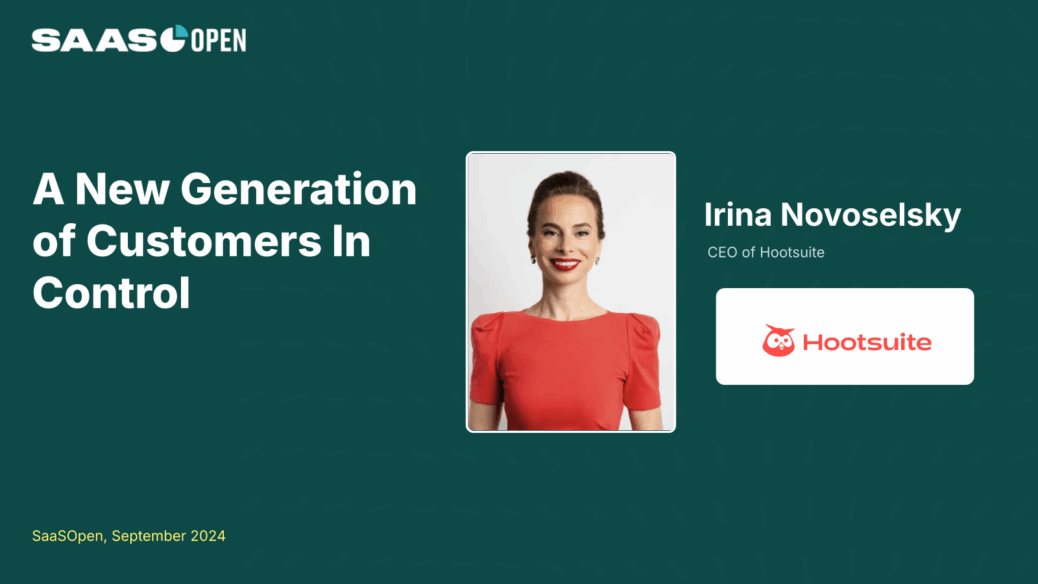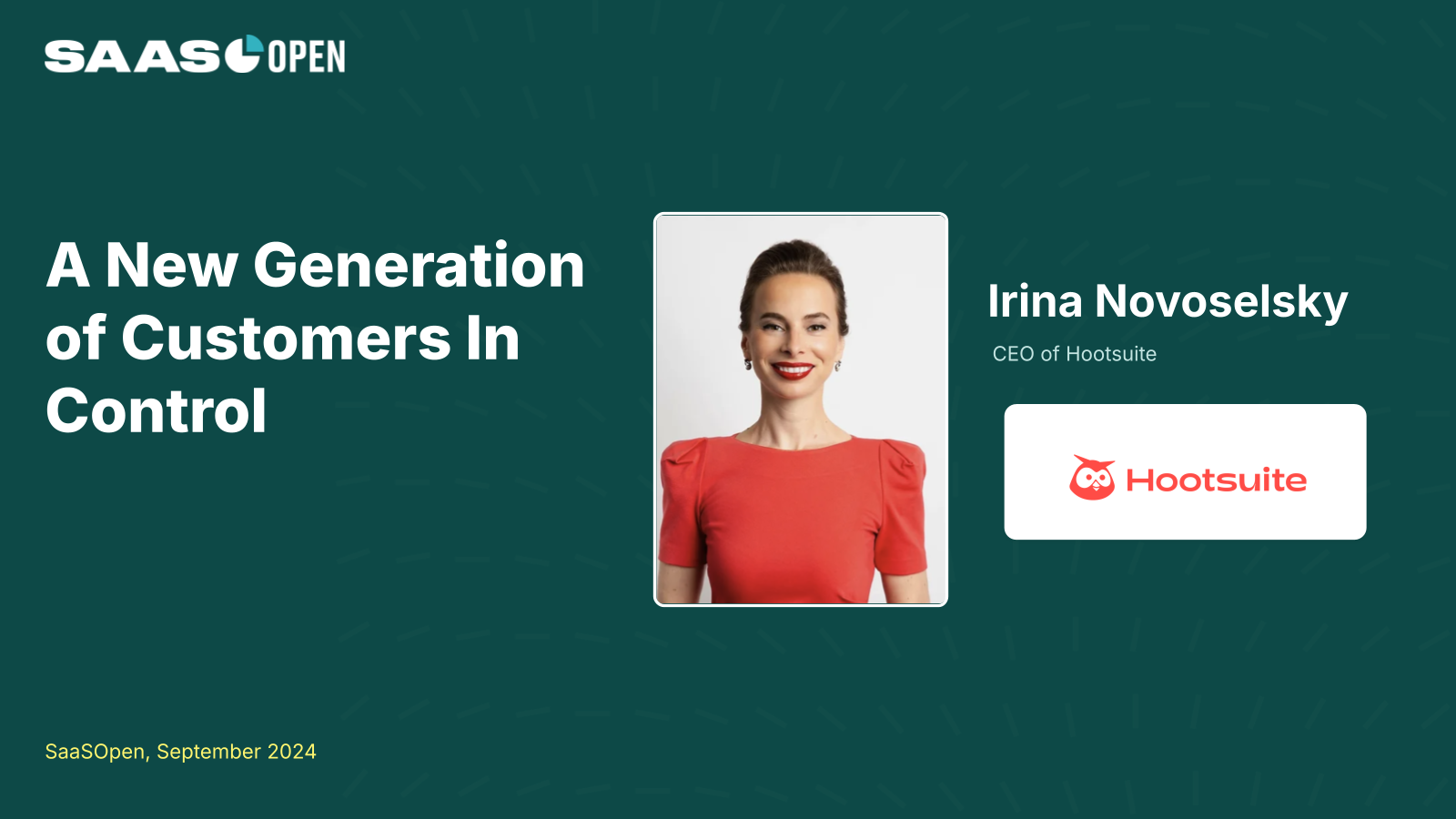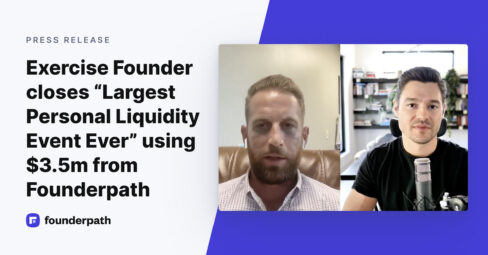How Hootsuite Grew From Agency Tool to $400 Million Revenue: Irina Novoselsky's Gen Z-First Playbook

This article was written and sourced from Irina Novoselsky’s keynote presentation at Founderpath’s last event. The images embedded below are from their slide deck. The full keynote recording is here.
When Irina Novoselsky joined Hootsuite as CEO in January 2023, the social media management pioneer was stuck in a revenue flatline despite being founded 15 years earlier as an agency tool that revolutionized social media management. In just 18 months, Novoselsky transformed the company’s trajectory by completely reimagining the SaaS playbook for a new generation of buyers, taking enterprise growth from 8% to 22% and pushing revenue toward $400 million annually.
The Ukrainian refugee turned tech executive didn’t just accelerate growth – she uncovered a seismic shift in B2B buying behavior that’s forcing every SaaS company to rethink their entire go-to-market strategy. By 2025, 75% of all buyers will be either Millennials or Gen Z, and they’re rejecting every traditional sales tactic in the book.
The Playbook: 5 Lessons from Hootsuite’s Journey to $400 Million Revenue
1. Embrace Self-Service Everything: 95% of Hootsuite’s business now comes inbound with no outbound sales force. Gen Z buyers complete 60% of their buying process before ever talking to sales – build your entire product experience around this reality.
2. Kill the Demo, Build Discovery: Traditional demos are dead. Instead of “click here for demo” CTAs, create self-guided product experiences like Monday.com where buyers can explore without human interaction. Two-thirds of Gen Z buyers want a fully digital purchase experience.
3. Win the 13-Piece Content Journey: Gen Z consumes at least 13 pieces of content before engaging with sales. They start on social (65% of B2B searches), not Google. Your content strategy must span Reddit, peer reviews, social platforms, and employee advocacy.
4. Executive Social Selling is Mandatory: 77% of buyers are more likely to purchase just from seeing executive presence on social. Social selling decreases CAC by almost 20%. CEOs who aren’t on social are invisible to the next generation of buyers.
5. Authenticity Over Artificial: Gen Z can detect BS instantly – they’re 50% less likely to respond to cold outreach and almost half use ad blockers. They trust peer recommendations and authentic voices, not polished marketing messages.
2008: Ryan Holmes Builds Hootsuite Through His Agency to Solve His Own Problem
Ryan Holmes began developing Hootsuite in 2008 through his agency, Invoke Media. Holmes needed a tool to manage multiple social media networks at his digital services agency, and finding no product in the market offering all the features he sought, he built his own solution.
This agency-first model proved powerful. As Nathan Latka noted in the introduction, many of today’s most successful SaaS companies started as agencies or professional services firms before productizing their solutions. Holmes understood his target customers intimately because he was one.

Seven of the 21 employees at Invoke were tasked to work on building out the Hootsuite tool, initially a freemium product. In 2009, Holmes raised $1.9 million in Series A funding and spun it off as an independent company.
2009-2013: From $3.8 Million to $165 Million Series B – The Viral Growth Years
Hootsuite hit $3.8M in revenue in December 2009. The platform spread rapidly through word-of-mouth among social media managers desperate for tools to manage the explosion of social networks.
Key milestones in Hootsuite’s early growth:
- November 2009: Expanded to support Facebook and LinkedIn beyond just Twitter
- December 2009: Spun off from Invoke Media with $1.9 million funding from Hearst Interactive and Blumberg Capital
- March 2012: OMERS Ventures invested $20 million, valuing the company at $200 million
- August 2013: Raised $165 million Series B, the largest ever for a Canadian software company at the time
The platform’s virality came from its network effects – as more team members joined organizations on Hootsuite, they brought the tool to their next companies. Companies using Hootsuite included Facebook, the Obama administration, HBO, Martha Stewart Media, Virgin Group, and Zappos.
2014-2022: The Plateau Years – Revenue Stalls at $150 Million Despite 18 Million Users
Hootsuite hit $150M in revenue in December 2019, December 2018, March 2018, and September 2017 – essentially flatlining for multiple years despite growing to 18 million users globally.
During this period, Hootsuite struggled with classic SaaS challenges:
- Increasing competition from specialized tools
- Longer sales cycles and declining productivity
- Rising customer acquisition costs
- Failed acquisition attempts (Goldman Sachs tried to broker a $750 million exit that didn’t materialize)
Hootsuite reached a $1 billion valuation in September 2014, but the company couldn’t sustain growth momentum. Traditional sales and marketing tactics were producing diminishing returns.
January 2023: Irina Novoselsky Arrives with a Transformation Mandate
Irina joined Hootsuite as CEO in January 2023, previously serving as CEO at CareerBuilder and holding positions at Novitex Enterprise Solutions, Apollo Global Management, and Morgan Stanley. She became the first female CEO of CareerBuilder at age 32.
Novoselsky brought a unique perspective as a Ukrainian refugee who moved to the U.S. at age four. Her “part spy, part anthropologist” approach to understanding human behavior would prove crucial in cracking the Gen Z code. She immediately went to work studying buyer patterns, meeting with 519 Gen Z professionals to understand their purchasing behavior.
Within 12 months, she achieved remarkable results: taking Hootsuite’s enterprise segment from 8% to 22% growth. But the real breakthrough came from her research into generational buying patterns.
2024: Revenue Surges to $350-400 Million by Throwing Out the SaaS Playbook
Hootsuite hit $350M in revenue in September 2024, with projections approaching $400 million by year-end. The transformation came from completely reimagining the customer journey for Gen Z buyers.
Novoselsky’s research revealed shocking statistics about the new generation of buyers:
- 62% of Gen Z employees are already involved in buying decisions
- 65% of B2B searches now start on social media, not Google
- 60% of the buying process is complete before talking to sales
- 50% consume at least 13 pieces of content before engaging
- 2 out of 3 want a fully digital purchase experience
These insights led to radical changes in Hootsuite’s go-to-market strategy. The company eliminated its outbound sales force, redesigned its entire demo process for self-service, and put social selling at the center of its growth strategy.
The Social Selling Revolution: 78% Higher Close Rates Through Executive Presence
One of Novoselsky’s most powerful discoveries was the impact of social selling. Salespeople leveraging social media outsell their peers by 78%, while 77% of buyers are more likely to purchase when they see executive presence on social platforms.
The transformation required Hootsuite’s entire leadership team to become active on social media. This wasn’t about broadcasting marketing messages – it was about authentic engagement, thought leadership, and being part of the conversation where buyers were already researching solutions.
Leveraging founder brand and executive visibility became a core growth driver. The average speaker at the SaaSOpen conference where Novoselsky presented had 10,000 followers, with top performers like Josh Aronov reaching 400,000 – demonstrating the power of personal brands in B2B sales.
The Self-Service Demo Revolution: How Monday.com’s Model Became the Blueprint
Traditional product demos were killing conversion rates. Gen Z buyers don’t want scripted pitches or to be forced into sales calls. Novoselsky highlighted Monday.com as the gold standard – allowing prospects to experience the entire product without human interaction.
Hootsuite completely rebuilt its demo experience to be self-service. Instead of “Request a Demo” CTAs that generated leads for sales teams, they created interactive product tours, free trials, and self-guided experiences that let buyers explore at their own pace.
This shift to self-service wasn’t just about technology – it represented a fundamental power transfer from seller to buyer. By putting buyers in control, Hootsuite aligned with Gen Z’s expectation of consumer-grade B2B experiences.
Check out Novoselsky’s complete keynote presentation to understand the full scope of this generational shift in buying behavior.
AI and the Future: Hootsuite’s $400+ Million Path Forward
AI usage on Hootsuite grew sharply by 318% for chatbots, 260% for AI-assisted image editing, and 195% for text generation. But Gen Z’s relationship with AI embodies their generational contradictions – they use it extensively but demand “authentic intelligence” over artificial intelligence.
Looking forward, Hootsuite’s growth strategy focuses on three key areas:
- Winning the Research Phase: Creating content for the 13-piece journey across Reddit, peer review sites, and social platforms where Gen Z researches
- Employee Advocacy: Turning employees into authentic brand ambassadors who can credibly engage in social conversations
- Continuous Self-Service Innovation: Building experiences that never require human interaction unless the buyer initiates it
The Bottom Line: Adapt or Get Ghosted
Hootsuite’s journey from a $3.8 million agency tool to approaching $400 million in revenue contains a critical lesson for every SaaS company: the traditional playbook is dead. Gen Z buyers have fundamentally different expectations, and companies that don’t adapt will find themselves ghosted without explanation.
Novoselsky’s transformation of Hootsuite proves that even 15-year-old companies can reinvent themselves by truly understanding their customers. By studying 519 Gen Z buyers like an anthropologist, she discovered that success requires putting buyers in complete control of their journey.
The metrics speak for themselves: 95% inbound revenue, 20% CAC reduction through social selling, and growth acceleration from 8% to 22% in just 12 months. For SaaS companies targeting the 75% of buyers who will be Millennials or Gen Z by 2025, Hootsuite’s playbook isn’t optional – it’s essential for survival.
The future belongs to companies that embrace self-service, authentic social engagement, and content-driven discovery. As Novoselsky warns, you’re already late if you’re not adapting today. Gen Z doesn’t do second chances – they’ll simply ghost you and move on to companies that understand their needs.
To learn more growth strategies from successful CEOs, apply for funding from Founderpath to get free access to upcoming in-person and virtual events.
If you’re an ambitious founder looking for capital to grow, we’d love to consider funding you at Founderpath. Click here to request capital.
Recent Articles
Top Growth Frameworks for Founders in 2025
The Ultimate Guide to Startup Growth Frameworks (With Real Founder Examples) Most founders think about growth in terms of tactics:…
Founderpath Frequently Asked Questions
What types of funding products does Founderpath offer? We currently offer two main products for B2B SaaS founders: Revenue-based financing:…

Founder Bootstrapped Using $3.5m From Founderpath, Exited for Massive Amount Last Week
Last week, Joel sold his bootstrapped software company. It was the biggest personal liquidity event of his career. Why? Because…